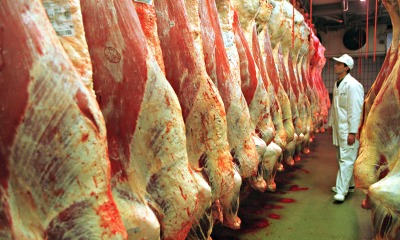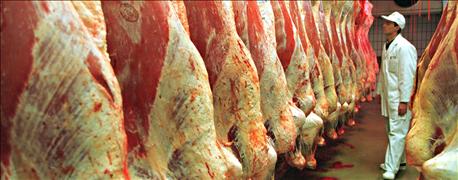
Balancing quality grade and yield grade is like walking a fine line, according to Darrell Busby, retired Iowa State University Extension beef specialist and coordinator at Tri-County Steer Carcass Futurity, which measures performance through retained ownership to provide opportunity for improvements in genetics and management.
Fat thickness is the biggest factor in yield grade, followed by ribeye area. Yield Grade and Quality Grade can be managed by sorting.

IMPROVING YIELD GRADE: Sorting, genetics and animal health all play a role in improving carcass quality.
The balance of 70% Yield Grades 1 and 2 and 70% Choice at closeout can usually be met at half an inch of back fat. Discounts for Yield Grades 5 and 4 are about $15 and $12, respectively. Meanwhile, premiums for Yield Grades 1 and 2 are about $6.50 and $3, respectively. "The key to making profit on the grid is avoiding the discounts," Busby says. "By sorting cattle, we usually run about 6% to 8% Yield Grade 4's. Right now, the industry is around 20%."
Discounts for lightweight carcasses start at less than 550 pounds, or a 1,000-pound live weight. Discounts for heavy carcasses start at over 1,050 pounds, or a 1,660-pound live weight. So, if a calf has less than 45/100 inch fat and weighs less than 1,000 pounds, it is fed for 35 more days. If it weighs more than 1,500 pounds, it is harvested.
A report published five years ago by Busby, former ISU Extension education director Perry "Bud" Beedle, and ISU Animal Science professor Daryl Strohbehn demonstrated producers earn an extra $11.41 to $18.64 based on how Tri-County sorts cattle. "We charge $10 to do the program," Busby says. "Just with how we sort the cattle, we can make up what it costs you to get the information."
Opportunity for improvement
There's even more value to be gained through improvements in genetics and management, including changing from a killed to modified live vaccination program in feeder cattle, timing of implants, creep feed rations, and a good preconditioning program. "If you retain ownership, you become responsible for the health program, the genetics, the management of those cattle," Busby says. "You are suddenly financially responsible for the whole thing."
While Quality Grade was something that came easy for Norman Garton's cattle, he realized he had room for improvement in Yield Grade. "Normally, we think of Angus cattle having more fat, so it's harder to get into Yield Grade 1 and 2 carcasses," says the Missouri beef cattle producer says. "To take off some of that extra fat, we're using Angus bulls that are negative for back fat but still positive on marbling and ribeye."
He's also seen the importance of herd health. "It was clear when a calf had to be treated for respiratory problems his average daily gain dropped," Garton says. His cattle have seen a difference in protection against infectious respiratory disease (IBR) during this winter's harsh weather after changing from a killed vaccine to a modified live. "Our calves actually gained 3.8 pounds per day from delivery to re-implant. Healthy animals go a long way."
Garton notes Missouri is the third state in the U.S. in total beef cow numbers, yet most of the calf crop is fed outside the state. "We've got quality cattle here. When they're shipped to Kansas and Nebraska, their feeding value is rated well. A lot of people change ownership at that point," he says. "The longer you can own that animal from conception to the packer, the more value you're going to add to your product."
About the Author(s)
You May Also Like






